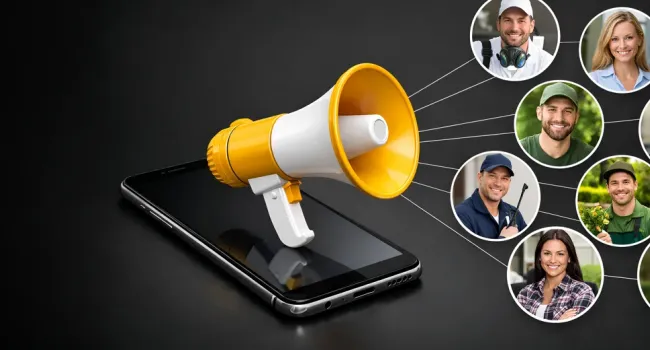DIY Marketing for Home Services - The Complete Guide

Growing a home service business requires strategic marketing that reaches customers where they are and converts them into loyal clients. Whether you're handling marketing yourself or evaluating partners, this guide provides actionable tactics for pest control, lawn care, HVAC, and other service businesses.
We'll be transparent about what you can realistically accomplish on your own versus when specialized expertise becomes essential for growth.
Key Takeaways
- Budget strategically: Allocate 5-10% of revenue toward digital marketing and focus on high-ROI channels like email ($36-$40 per dollar spent).
- Use multiple channels: 82% of small businesses report better results using multiple marketing channels—combine SEO, paid ads, social media, email, and print.
- Prioritize reviews: 95% of customers consult online reviews, and you need at least 40 reviews to establish credibility.
Quick Navigation
- Marketing Budget
- 8-Step Marketing Plan
- DIY vs. Professional Help
- Content & Social Media
- Paid Advertising
- Customer Retention
- AI Marketing Tools
- FAQ
Building Your Marketing Budget
A well-planned budget helps you allocate resources effectively and measure success. Follow these steps:
1. Define SMART Goals
Specific, Measurable, Achievable, Relevant, Time-based. Instead of "increase sales," aim for "grow revenue by 10% in Q2." Track website visits, conversion rates, and lead generation numbers.
2. Analyze Past Performance
Review past campaigns to identify which strategies delivered the best ROI. Track conversion rates and customer acquisition cost.
3. Understand Your Market
80% of small businesses survive their first year, but only 50% make it to five years (SBA.gov). Understanding your competitive landscape and local market saturation is essential.
4. Choose Your Channels
Prioritize based on your audience:
- Email Marketing: Highest ROI at $36-$40 per $1 spent
- SEO/Paid Search: Capture high-intent searchers
- Social Media: Build engagement and brand awareness
- Content Marketing: Attract and convert potential customers
- Print Marketing: 71% of small businesses find physical marketing important
5. Set Your Budget
Allocate 5-10% of revenue toward digital marketing. Break down into:
- Advertising costs (media buys, PPC, social media)
- Content creation (design, video, writing)
- Software and tools (email platforms, CRM, analytics)
- Personnel costs (team salaries or agency fees)
6. Account for Seasonality
Pest Control: Increase marketing spend 2-3 months before peak seasons. Start campaigns in January-February to capture pre-emergent market share before competitors flood the market in March-April.
Lawn Care: Intensify marketing in late winter (January-February) when homeowners plan spring lawn programs. Promote fall services starting in July-August.
Year-Round: Maintain baseline marketing during off-seasons to capture emergency services and build brand for the next busy season.
7. Monitor and Adjust
Regularly track performance and pivot when strategies underperform.
Your 8-Step Marketing Plan
1. Define Your Target Audience
Identify ideal customers by age, location, income, profession, and pain points. For lawn care, consider whether you're targeting affluent neighborhoods or budget-conscious families seeking eco-friendly solutions.
2. Set SMART Goals
Categories include increasing customer base, generating leads, improving retention, or boosting sales. Make them specific, measurable, attainable, relevant, and time-bound.
3. Develop Your Value Proposition
Identify unique selling points (USPs) that differentiate you from competitors. Research competitors, survey customers, and create compelling messaging like "accurate estimates with no hidden fees" or "satisfaction guarantee."
4. Choose Marketing Channels
76% of small business owners use at least 2 marketing channels. Consider:
- Social Media (Facebook, Instagram, LinkedIn)
- Email Marketing (updates, promotions, news)
- Pay-Per-Click Advertising (Google, Facebook ads)
- Direct Mail (flyers, postcards, door hangers)
- Trade Shows (networking, lead generation)
5. Create Content Strategy
Develop practical how-to content, share customer success stories, create educational videos, and provide actionable information that aligns with your channels and goals.
6. Launch Campaigns
Implement campaigns with consistent branding across all channels: Facebook ads, email newsletters, SEO, SEM, and digital advertising.
7. Measure Results
Use Google Analytics for website traffic, monitor social media engagement, and conduct customer surveys. Analyze click-through rates, conversion rates, and engagement metrics.
8. Adjust Your Plan
Review quarterly or annually. Identify opportunities for improvement and optimize campaigns as your business and audience evolve.
DIY vs. Professional Help
What You Can Effectively DIY
- Social Media Management: Free (time investment only)
- Google Business Profile: Free and critical for local visibility
- Basic Email Marketing: $10-50/month for platforms like Mailchimp
- Review Generation: Free (or $50-200/month for automation)
- Basic Print Marketing: $200-1,000/month for printing and distribution
Where DIY Gets Challenging
- Content Creation: Expect 6-12 month learning curve. Watch out for AI tool errors and quality issues.
- Website Management: Budget 5-10 hours monthly once proficient
- Social Media Advertising: Expect to spend $500-1,000 learning before seeing positive ROI
When Professional Expertise Becomes Essential
- SEO: Properly optimized websites generate 50-200+ qualified leads monthly. Most home service owners lack the time to do this effectively while running operations.
- Google Ads (PPC): The Average business wastes $2,000-5,000 before figuring out what works. Experts reduce cost-per-lead by 40-60%.
- Conversion Rate Optimization: Small improvements can double results from existing traffic.
- Strategic Planning: Industry-specific expertise prevents costly mistakes and accelerates growth.
- AI-Powered Marketing: Without expertise, AI leads to hallucinations, poor-quality content, and wasted effort.
The Hybrid Approach
Handle in-house: Social media posting, review responses, basic email campaigns
Outsource strategically: SEO, Google Ads, website development, content strategy, conversion optimization
Decision Questions
- Can you dedicate 10+ hours weekly to marketing?
- What would 20-30 more monthly customers be worth? (If $50,000+/year, professional marketing pays for itself quickly)
- Are you technically inclined and enjoy learning new platforms?
- Do competitors invest heavily in marketing?
- What's your actual cost per hour? (10 hours monthly at $100-150/hour = $1,000-1,500 in lost service revenue)
Want an honest assessment? Contact Coalmarch for a complimentary consultation. We'll identify quick wins you can implement yourself and show where our expertise can accelerate growth.
Content & Social Media Strategy
Understanding the Awareness Ladder
Create content based on where your audience falls in awareness:
- Not aware they have a problem
- Aware that they have a problem
- Known solutions exist
- Contemplating your solution
- Know your solution and benefits
- Convinced your solution is right
Blog readers differ from service page visitors. Don't oversell on blogs. Match calls-to-action to readiness. Make content scannable with bullet points and headings.
Social Media Best Practices
With 55% of consumers discovering brands through social media, a strong strategy is crucial.
Benefits of in-house management:
- Maintains consistent brand identity
- Enables quick, authentic customer engagement
- Allows budget focus on higher-ROI strategies (SEO, SEM)
- Reduces back-and-forth with agencies
Tips for effectiveness:
- Have clarity of purpose with your team
- Prioritize quality over quantity
- Keep posts simple and authentic
- Delegate to interns, new technicians, or receptionists
- Share reputable content from sources like The Spruce, PestWorld, and Country Living
Social Media for Recruitment
- Post job openings to reach qualified candidates
- Showcase organizational culture with team photos and volunteer events
- Monitor direct messages for employment inquiries
Build your team with a customized CareersSite.
Paid Advertising
Meta Advertising (Facebook & Instagram)
83.3% of small business owners use Facebook advertising; 47.9% use Instagram.
Success factors:
- Understand your audience: Use Meta's targeting tools for interests, behaviors, and life events
- Captivating creative: Test videos, carousels, and static images with bold visuals and clear CTAs
- Data-driven decisions: Monitor CTR, conversion rates, and engagement. Adjust targeting and creative based on performance
- Stay current: Follow algorithm changes and emerging best practices
- Test and optimize: Run A/B tests on headlines, images, and CTAs. Test one variable at a time
Zero-Click Search
Zero-click search occurs when users find answers directly on the SERP without visiting websites. Google displays featured snippets, knowledge panels, location details, and reviews.
Optimization strategies:
- Create high-quality content: Address user intent and answer questions directly for featured snippets
- Increase brand awareness: Position as thought leader and subject matter expert
- Ensure information consistency: Keep name, locations, hours, contact info, and services up-to-date across all platforms
Learn more about optimizing your Google Business Profile.
Customer Retention Strategies
Building a Review Generation System
Key statistics:
- 95% of customers consult online reviews
- Nearly 50% trust online reviews as much as personal recommendations
- 55% say reviews for service businesses are "very important."
- 87% use Google to research local businesses
- Almost two-thirds will leave a review when asked
Five-step process:
- Claim and optimize listings across Google Business Profile, Yelp, Facebook, and Angie's List. Add photos and videos
- Train your team: Everyone should know how to request reviews politely and professionally
- Send follow-up emails: Most effective method. Include direct links to review sites with clear instructions
- Display reviews prominently: Share on social media and website as testimonials
- Respond to every review: 90% of customers say it's important that businesses respond to all reviews. Customers are 2x more likely to consider you if you respond actively
Download our free Review Generation Playbook for scripts and templates. Learn how to get Nextdoor reviews.
SMS Marketing
It's more affordable to retain customers than to attract new ones. SMS delivers impressive results:
- 98% open rate for business texts
- 209% higher response rate than email, phone, or Facebook
- The majority of customers prefer text for customer service
Applications:
- Appointment reminders: "Our service team will be at your home @ 1:00 PM."
- Quick answers: Customers can text questions about scheduling or procedures
- Education: "As winter approaches, we can safeguard your home against mic.e"
- Promotions: "Special offer for valued customers—save 20% on your next treatment.t"
- Feedback requests: "Do you have a moment for a quick survey?"
Best practices: Keep messages short, don't over-message, connect to a larger platform, and A/B test frequently.
Service Bundling
Bundling creates win-win value while adding recurring revenue streams.
Three-tier approach:
- Basic Package: Minimum service at a low price
- Premium Package: Comprehensive services at a higher monthly rate
- Mid-Tier Package: Sweet spot for average customers
Benefits:
- Customers get services without paying à la carte
- You consolidate services in one trip (saves operational costs)
- Creates a recurring revenue stream
- Simplifies decision-making (prevents paralysis by analysis)
- Opens pathway for upgrades and add-ons
Learn more about what marketing bundles are and why they're a smart strategy.
Leveraging AI (Carefully)
59% of small businesses incorporate AI into their marketing, and those that do are 5.7x more likely to report greater success. However, success requires expertise—not just access to technology.
What AI Can Do
- Customer service responses
- Job descriptions for recruiting
- Personalized sales pitches
- Internal communications
- Content ideation and brainstorming
- Data analysis from customer feedback
Explore 5 ways AI can boost your business when implemented correctly.
Critical Warnings About DIY AI
AI "Hallucinations" are real: OpenAI acknowledges ChatGPT "sometimes writes plausible-sounding but incorrect or nonsensical answers." These can include fabricated statistics, false claims, incorrect advice, or made-up testimonials—damaging credibility and creating liability.
Quality control requires expertise: AI lacks emotional intelligence for a genuine connection. Without oversight, AI produces content that:
- Contradicts your brand voice
- Contains technical inaccuracies
- Fails to address local market needs
- Misses compliance requirements
- Sounds generic instead of expert
Wrong approach costs more: Businesses waste time and money on DIY AI, discovering:
- Content doesn't rank in search engines
- Customers recognize AI-generated content and don't trust it
- Inaccurate information requires expensive corrections
- Hours spent editing would be better spent on service delivery
Read about Google's March 2024 core update targeting AI content.
How Coalmarch Uses AI Right
- Expert human oversight: Every piece reviewed and enhanced by industry professionals
- Industry-specific training: We understand technical details and prompt AI correctly
- Fact-checking protocols: Verify every statistic and recommendation
- Strategic implementation: Use AI for data analysis and ideation; rely on humans for strategy and emotional connection
- Continuous optimization: Monitor performance and adjust based on actual results
Want to leverage AI without the risks? Contact Coalmarch to discuss packages tailored to your needs and budget.
Frequently Asked Questions
How much should I budget for marketing?
Allocate 5-10% of revenue toward digital marketing. Growth-mode companies may invest 10-15%; established businesses maintaining market share might spend 3-5%. Track ROI and adjust accordingly.
What channels deliver the best ROI?
Email marketing delivers the highest ROI ($36-$40 per dollar spent). For lead generation, combine SEO, local search optimization, Google Ads, and strategic social media. 82% of small businesses agree that using multiple channels leads to better results.
How many reviews do I need?
At least 40 reviews before star ratings appear credible. However, start requesting reviews immediately—even a handful of authentic, detailed reviews provides value. Build your portfolio systematically over time.
Should I manage social media in-house or hire an agency?
Depends on resources and goals. In-house offers authenticity and allows budget allocation toward higher-ROI strategies (SEO, SEM). Consider a hybrid: manage organic social in-house while specialists handle paid advertising and the overall digital marketing strategy.
How do I know if marketing is working?
Track KPIs: cost per lead, lead-to-customer conversion rate, customer acquisition cost, lifetime customer value, website traffic and conversion rates, and return on ad spend (ROAS). Review metrics monthly; adjust strategy quarterly.
What's the difference between SEO and paid search?
SEO improves organic rankings through optimization, content, and technical improvements. Results take 3-6 months but compound over time without ongoing ad spend. Paid search (Google Ads) delivers immediate visibility but requires continuous budget. Most successful businesses use both. Learn more about lawn care SEO and Google Ads automation.
How often should I post on social media?
Quality over quantity. Post 2-3 times per week with valuable content rather than daily mediocre content. Consistency matters more than frequency. For most home service businesses, 3-5 times per week across all platforms is sufficient.
Can AI replace my marketing team?
No. AI is prone to hallucinations (false information), produces generic content that fails to convert, and lacks industry expertise. Without proper oversight, AI can lead to technical inaccuracies, compliance failures, and damage to credibility.
At Coalmarch, we leverage AI as a tool while maintaining human expertise that drives real results. We use AI for efficiency and scale, but every piece is reviewed, fact-checked, and optimized by professionals who understand home service industries. We offer packages for businesses of all sizes to benefit from expert AI implementation without the risks of DIY.
The most effective approach combines AI's efficiency with the expertise of experienced marketing professionals who know how to use it strategically for your specific industry.
How do I compete with larger companies?
Focus on unique advantages: local expertise, personalized service, community involvement, and authentic relationships. Emphasize USPs in all marketing. Establish robust local presence through Google Business Profile optimization, local SEO, community partnerships, and consistent review generation. Many consumers prefer supporting local businesses—highlight what makes you different and better. Read our guide on the importance of brand positioning.
What's the most important thing I can do right now?
Start systematically requesting online reviews. With 95% of customers reading reviews before purchasing, and reviews providing fresh content that improves search visibility, a strong review strategy delivers immediate and long-term benefits. It's free (besides time investment), builds credibility, improves rankings, and provides social proof. Make asking for reviews part of every customer interaction.
Ready to take your home service marketing to the next level? At Coalmarch, we specialize exclusively in marketing for home service businesses. We understand the seasonal nature, the importance of local SEO, and how to leverage AI effectively without quality risks.
We offer packages for businesses of all sizes—from solo operators to multi-location enterprises—with transparent pricing and measurable results.
Contact Coalmarch for a complimentary, no-pressure consultation. We'll provide an honest assessment of what you can handle independently and where our expertise can make the biggest impact. You'll walk away with actionable insights whether or not you work with us—because we believe in delivering value from the very first conversation.




